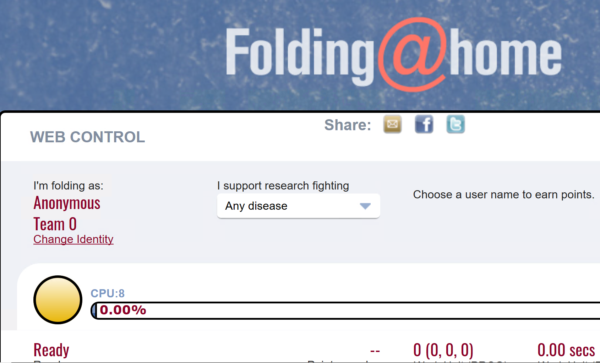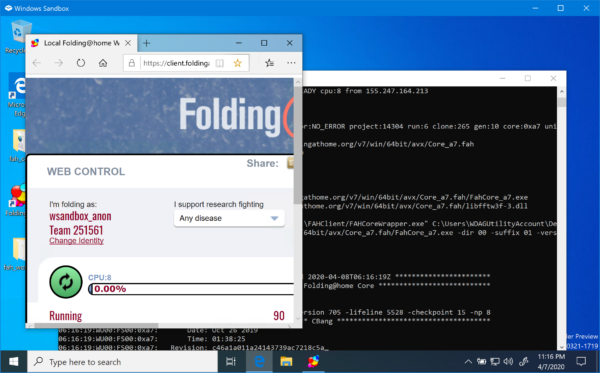In this world, computing power leads to miracles. Computing power can play a major role in solving problems that revolve around us. This is one of the reasons the entire tech industry (including Microsoft) is invested in Quantum computing, which will help to make a computer more efficient in solving these problems. Folding Home is a distributed computing project that performs molecular dynamics simulations of protein dynamics.
Microsoft has posted a detailed guide on how anyone can donate their computer’s resources to the project. In this guide, we will discuss how to securely donate CPU time with Windows Sandbox.

Securely donate CPU time using Windows Sandbox
Before you get started, you need to make sure that Windows Sandbox is enabled on your computer.
Now, open Notepad and copy and paste the following code in it:
#Requires -RunAsAdministrator
#For a custom username, add -username <your username> to the command execution
param([string]$username=‘wsandbox_anon‘)
$ProgressPreference = ‘SilentlyContinue‘ #Progress bar makes things way slower
# Ensure that virtualization is enabled in BIOS.
Write-Output ‘Verifying that virtualization is enabled in BIOS…‘
if ((Get-WmiObject Win32_ComputerSystem).HypervisorPresent -eq $false) {
Write-Output ‘ERROR: Please Enable Virtualization capabilities in your BIOS settings…‘
exit
}
# Determine if Windows Sandbox is enabled.
Write-Output ‘Checking to see if Windows Sandbox is installed…‘
If ((Get-WindowsOptionalFeature –FeatureName ‘Containers-DisposableClientVM‘ –Online).State -ne ‘Enabled‘) {
Write-Output ‘Windows Sandbox is not installed, attempting to install it (may require reboot)…‘
if ((Enable-WindowsOptionalFeature –FeatureName ‘Containers-DisposableClientVM‘ –All –Online –NoRestart).RestartNeeded) {
Write-Output ‘Please reboot to finish installing Windows Sandbox, then re-run this script…‘
exit
}
} else {
Write-Output ‘Windows Sandbox already installed.‘
}
# Download the latest version of FAH.
Write-Output ‘Checking for latest version of foldingathome…‘
$installer_url = ‘https://download.foldingathome.org/releases/public/release/fah-installer/windows-10-32bit/‘
# Use regex to get the latest version from the FAH website.
$version = ((Invoke-WebRequest –Uri $installer_url –UseBasicParsing).Links | Where-Object {$_.href -match ‘^v\d+([.]\d+)?‘} | ForEach-Object {[float]($_.href -replace ‘[^.\d]‘, ‘‘)} | Measure-Object –Max).Maximum
$installer = “$($installer_url)v$($version)/latest.exe“
$installer_size =(Invoke-WebRequest $installer –Method Head –UseBasicParsing).Headers.‘Content-Length‘
Write-Output “Using FAH v$version.“
# Check if the installer is present, download otherwise.
$working_dir = “$env:USERPROFILE\fah_conf“
$install_fname = ‘folding_installer.exe‘
If (!(test-path “$working_dir\$install_fname“) -or (Get-ChildItem “$working_dir\$install_fname“).Length -ne $installer_size ) {
Remove-Item “$working_dir\$install_fname“ –Force –ErrorAction SilentlyContinue
Write-Output “Downloading latest folding executable: $working_dir\$install_fname“
Write-Output “Saving to $working_dir\$install_fname…“
New-Item –ItemType Directory –Force –Path $working_dir | Out-Null
Invoke-WebRequest –Uri $installer –OutFile “$working_dir\$install_fname“
}
# Create the FAH configuration file with the Windows Sandbox FAH team #251561.
Write-Output ‘Creating init command…‘
$conf_file = ‘fah_sandbox_conf.xml‘
Write-Output “Saved Folding@Home configuration file to $working_dir\$conf_file“
New-Item –Force –Path “$working_dir\$conf_file“ –ItemType File
Set-Content –Path “$working_dir\$conf_file“ –Value @”
<config>
<user v=’$username‘/>
<team v=’251561’/>
<core-priority v=’low’/>
<power v=’full’ />
<priority v=’realtime’/>
<smp v=’true’/>
<gpu v=’true’/>
<open-web-control v=’true’/>
</config>
“@
<#
Create the script that runs at logon. This script:
1. Starts the installer
2. Creates a volatile working directory
3. Copies the config into the working directory
4. Sets the firewall policies to let FAH run
5. Starts the FAH client
#>
Write-Output ‘Creating init command…‘
$logon_cmd = “$working_dir\init.cmd“
$wdg_install_dir = ‘C:\users\wdagutilityaccount\desktop\fah_conf‘
$wdg_working_dir = ‘C:\users\wdagutilityaccount\desktop\fah_working_dir‘
Write-Output “Saved logon script to $logon_cmd, this will be run upon starting Sandbox.“
New-Item –Force –Path $logon_cmd –ItemType File
Set-Content –Path $logon_cmd –Value @”
start $wdg_install_dir\$install_fname /S
goto WAITLOOP
:WAITLOOP
if exist “C:\Program Files (x86)\FAHClient\FAHClient.exe” goto INSTALLCOMPLETE
ping -n 6 127.0.0.1 > nul
goto WAITLOOP
:INSTALLCOMPLETE
mkdir $wdg_working_dir
cd $wdg_working_dir
echo \”Copying config file to $wdg_working_dir\”
copy $wdg_install_dir\$conf_file $wdg_working_dir
netsh advfirewall firewall Add rule name=”FAHClient” program=”C:\Program Files (x86)\FAHClient\FAHClient.exe” action=allow dir=out
netsh advfirewall firewall Add rule name=”FAHClient” program=”C:\Program Files (x86)\FAHClient\FAHClient.exe” action=allow dir=in
start C:\”Program Files (x86)”\FAHClient\FAHClient.exe –config $wdg_working_dir\$conf_file
“@
# Create the Sandbox configuration file with the new working dir & LogonCommand.
$sandbox_conf = “$working_dir\fah_sandbox.wsb“
Write-Output “Creating sandbox configuration file to $sandbox_conf“
New-Item –Force –Path $sandbox_conf –ItemType File
Set-Content –Path $sandbox_conf –Value @”
<Configuration>
<VGpu>Enable</VGpu>
<MappedFolders>
<MappedFolder>
<HostFolder>$working_dir</HostFolder>
<ReadOnly>true</ReadOnly>
</MappedFolder>
</MappedFolders>
<LogonCommand>
<Command>$wdg_install_dir\init.cmd</Command>
</LogonCommand>
</Configuration>
“@
# For convenience, start the Sandbox.
Write-Output ‘Starting sandbox…‘
Start-Process ‘C:\WINDOWS\system32\WindowsSandbox.exe‘ –ArgumentList $sandbox_conf
Alternatively, you could just download it from Microsoft’s GitHub repository.

Once done, just run it with Windows PowerShell and it will start a Windows Sandbox environment that will donate your computer’s resources to the distributed computing project.
All the best!
Leave a Reply